Horse chestnut leaf miner
Cameraria ohridella
Appearance
The chestnut leaf miner is a butterfly up to 5 mm in size. The copper-colored forewings bear white transverse bands, which are banded black on the outside. The insect's hind wings are fringed, which is interpreted as an adaptation to hovering as so-called aerial plankton.
The larvae are perfectly adapted to life inside the leaf (the mine) with their flattened body, greatly reduced legs, and flat, triangular head with powerful mouthparts. They go through four to five feeding stages before reaching their final size of about 5 mm.
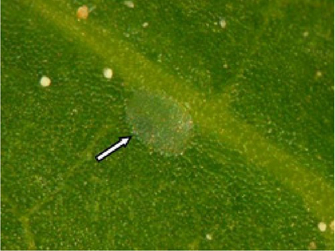
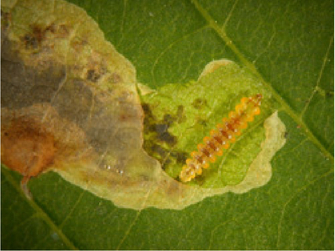
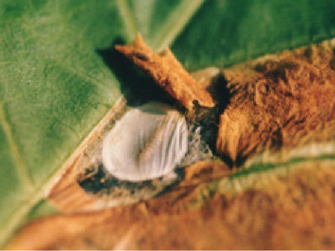
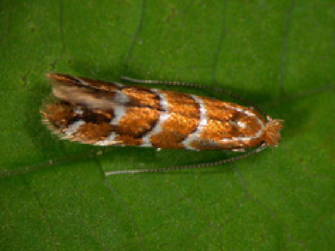
Biology
The chestnut leaf miner is also called horse chestnut leaf miner and belongs to the leaf miner family (Gracillariidae). The name "leaf miner moth" indicates the way the larvae live. After hatching from the egg, these bore into the leaf and feed in the upper tissue layers without damaging the epidermis of the leaf above. In this way, closed cavities are created in the leaf, the so-called "mines". The larvae can develop in these mines, protected from external influences.
The annual development cycle of the chestnut leaf miner begins with the hatching of the moths after overwintering, around mid-April. Beginning in late April, females lay up to 70 eggs on the upper leaf surface of horse chestnut leaves. The oval eggs, less than 0.5 mm in size and almost transparent, are preferentially laid in the surface depressions near the leaf veins and are barely visible to the naked eye. After about ten days, the larva hatches and immediately bores into the leaf. All development now takes place within the leaf in the mine. The larvae mainly feed on the upper part of the leaf tissue, the so-called palisade parenchyma, which is rich in chlorophyll and accounts for the green coloration of the leaf.
The feeding larvae are followed by two spinning larval stages, the first of which lines the mine floor with webs, creating a slight bulge on the underside of the leaf. In the bulge thus created, the second spinning stage makes a lenticular cocoon in which pupation takes place. The entire larval development takes about a month, depending on the weather, followed by about two weeks of pupal dormancy.
From about mid-June, the first moths of the "spring generation" hatch in our latitudes. At least two more generations follow, with the moths of the "summer generation" swarming from mid-August until well into the fall. The moths of the third generation usually do not hatch in the same year, but overwinter in the pupal stage in their cocoons in the mines of fallen leaves. After a hibernation period of about six months, the moths hatch from the fallen leaves the following spring and the development cycle begins anew.
Damage symptoms
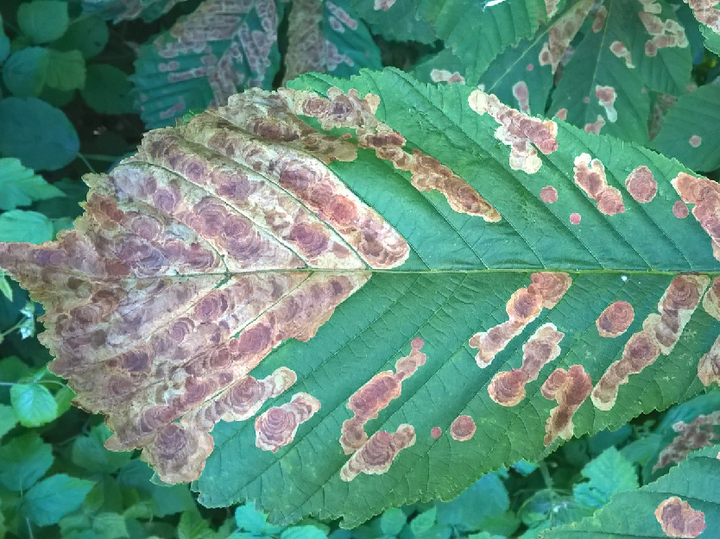
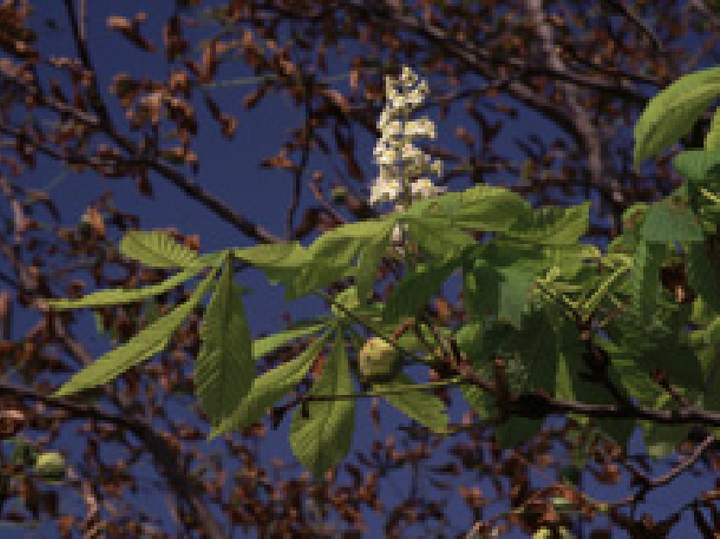
The larvae of the chestnut leaf miner can cause incalculable damage, which is caused to the leaves of horse chestnuts. In the summer months, this causes entire trees to turn brown prematurely. It is now known that the effects of the moth infestation on the health of the trees are far less serious than the visual impression would lead one to believe. Nevertheless, the aesthetics and recreational function of public green spaces in Europe's urban areas are severely impaired.
Due to the feeding activity of the larvae, the upper epidermis above the infested areas on the leaf is cut off from the water supply and wilts. In this way, the typical brown spots visible only on the upper leaf surface are formed. In case of heavy infestation, individual mines merge into each other, resulting in large, irregular browning. In extreme cases, the entire leaf surface may be undermined by dozens to hundreds of caterpillars. As a result, heavily infested leaves dry out and curl in from the edges. Horse chestnuts then turn completely brown as early as July, and by August foliage fall can begin.
On superficial inspection, the damage pattern of the leaf miner can be mistaken for leaf margin necrosis, which is caused by drought stress. In addition, a plant pathogenic fungus, Guignardia aesculi, also produces brown spots on horse chestnut leaves. However, if the leaves are held up to the light, small grubs or traces of their excretions are visible in the mines. As an additional distinguishing feature, the spots caused by drought stress or fungal attack are equally visible on the upper and lower leaf surfaces and are often surrounded by a yellow margin.
Defoliated trees sometimes sprout a second time, and in isolated cases an "emergency bloom" may occur in late summer and fall. However, this phenomenon is not due to leaf miner infestation alone, but is a general response of horse chestnuts to stressful situations.
Recent studies have shown that physiological damage to horse chestnuts from even heavy leaf miner infestations is low. Tree growth and storage of reserve materials occur largely during the first half of the year. Until the end of June, the extent of destruction of the leaf surface, even in the case of heavy infestation, is not yet so great that the photosynthetic performance of the horse chestnuts would be significantly impaired.
It is not until the second half of the year that the loss of functional leaf area becomes noticeable in the water and nutrient balance of the trees. During this period, most of the assimilates (such as carbohydrates and glucose) are invested in seed production. That is why moth infestation does not have serious consequences for chestnut. Only the quality of seeds depends on the level of infestation, but this does not matter for planted trees in urban areas.
Host plants
The most important host plant of the chestnut leaf miner is the white-flowered horse chestnut(Aesculus hippocastanum L.). This tree species enjoys great popularity because of its splendid blossom in spring. On the other hand, the moth cannot develop on the sweet chestnut (Castanea sativaL.).
There are reasonable doubts as to whether the white-flowered horse chestnut is actually the original host plant. For example, it is surprising that the small butterfly has only spread across Europe in the past 20-30 years, although its host plant has been widely distributed for more than 300 years. Equally striking is the mass infestation of horse chestnuts, which has been going on for decades. These epidemic population densities of the leaf miner are more indicative of a food resource that has only recently been tapped, rather than a relationship between plant and herbivore that has been well-rehearsed over evolutionary time periods. In any case, there will be no clarity about the original host plant until its geographic origin has been clarified (see Distribution).
In addition to the white-flowered horse chestnut, minor infestations by the chestnut leaf miner have also been found on other horse chestnut species, for example on Aesculus x carnea, a red-flowered hybrid of the common horse chestnut and the American red pavia(Aesculus pavia L.), which is also frequently planted in Europe. However, leaf miner mortality is very high on these host plants, likely due to both mechanical barriers and toxic leaf constituents. Of the approximately 20 species of horse chestnut known worldwide, most American species are likely to be largely resistant to infestation by the chestnut leaf miner.
Distribution
The chestnut leaf miner now occurs throughout Europe, from Greece, the Dalmatian coast, northern Italy and southern France in the south to southern Scandinavia, northern Germany, Denmark, the Benelux countries and England in the north. The current western limit of spread is in France and Spain, with the easternmost reports coming from the Ukraine.
The leaf miner probably first appeared on artificially planted horse chestnut stands in the region around Lake Ohrid (Macedonia) in the early 1970s. In autumn 1989, isolated mines of the chestnut leaf miner were found in the Linz area. As early as 1990/91, mass reproduction was detected there, and in 1992 the moth was discovered in the St. Pölten area. Since then, the pest has spread explosively throughout Austria. Starting from this second source of infestation in Austria, the chestnut leaf miner spread mainly to the north-west, but also to the neighbouring countries to the east and south. In addition, the population also expanded its range from the area of discovery in Macedonia to the other Balkan countries and Eastern Europe.
Despite years of searching worldwide, the original origin has not yet been clarified. Various possibilities are currently being considered. The most likely is that the moth originated in East Asia, where there are close relatives of leaf miners.
In their original habitat, the population densities of leaf miners could be so low that they have not yet caused any significant damage. It is also possible that the chestnut leaf miner actually originates from the Balkans or from a neighbouring area of origin in Asia Minor. In this case, it would be very likely that the rapid spread in Europe only took place after a change of host plant in recent decades.
Prevention and control
- In isolated, manageable stands of horse chestnut, thorough removal of fall foliage in autumn, and thus of overwintering stages, can significantly reduce infestations the following spring. The foliage should be disposed of with household waste or in large-scale composting facilities. However, this measure is only effective against the first generation. By the next fall at the latest, however, the moth population has recovered and the third generation of moths can already reach epidemic proportions again.
- A pheromone specific to the chestnut leaf miner moth can be used before the first and second generations begin to fly. The pheromone attracts the male moths. This results in a reduction in egg laying and a reduction in the intensity of the damage. Depending on the type of trap used, this measure is used for infestation control or direct control.
- The pheromone funnel trap consists of a collecting container filled with water and some dishwashing detergent, with a funnel and lid attached, and is suitable for mass trapping of male moths. Depending on the weather, the funnel trap should be hung in the tree crown and near the trunk from the beginning/middle of April. A pheromone change should be made every four to six weeks and the trap should remain in the tree until September.
- The pheromone delta trap (with adhesive base) is ideal for determining the start of flight as well as estimating moth density.
- In addition to these traps, it is possible to place a glue ring on the trunk at the beginning of the moth flight to prevent the flight-bearing females from crawling up into the crown. This measure is most effective in April after hatching or mating.
- The use of chemical pesticides should be carefully considered for both environmental and cost reasons. The active ingredient azadirachtin is effective against the larvae of the chestnut leaf miner moth (see list of plant protection products approved in Austria).
- The optimal time of application, after the complete unfolding of the horse chestnut leaves (that is when the first chestnut flowers appear), the hatching of the larvae or when the first leaf mines become visible, is decisive for the control success.
Specialized information
Publications
Blümel, S., Hausdorf, H., 1997. experiments on the control of Cameraria ohridella Deschka & Dimic with insecticidal growth regulators. Forstschutz aktuell 21, 16-18.
Lethmayer, C., Grabenweger, G., 1997. natural parasitoids of the chestnut leaf miner moth. Forstschutz Aktuell 21, 30.
Lethmayer, C., 1997. the chestnut leaf miner (Cameraria ohridella), an important pest on chestnut trees. Plant Protection 3, 6-7.
Backhaus, G. F., et al, 2002. the horse chestnut leaf miner (Cameraria ohridella) - biology, distribution, and countermeasures. Nachrichtenbl. Deut. Pflanzenschutzd. 54(3), Eugen Ulmer GmbH & Co, Stuttgart, 56-62. ISSN 0027-7479.
Lethmayer, C., 2002. the parasitism of the horsechestnut leafmining moth (Cameraria ohridella) in Austria. In: Melika, G., Thuroczy, C. (Eds.), Parasitic wasps: Evolution, Systematics, Biodiversity and Biological Control. Agroinform, Budapest, 400-404.
Lethmayer, C., 2003. over 10 years of Cameraria ohridella (Gracillariidae, Lepidoptera) - new beneficial insects? Entomologica Austriaca 8, 3-6.
Lethmayer, C., 2005. 10 years of experience with the invasive horse chestnut leafminer (Cameraria ohridella) in Austria. In: Alford, D. V., Backhaus, G. F. (Eds.), Plant Protection and Plant Health in Europe: Introduction and Spread of Invasive Species. BCPC Symposium Proceedings 81, 61-66.
Kovacs, G., Lethmayer, C., 2006. control options for the chestnut leaf miner. The Plant Doctor 5, 26-27.
Grabenweger, G., Kehrli, P., Zweimüller, I., Augustin, S., Avtzis, N., Bacher, S., Freise, J., Girardoz, S., Guichard, S., Heitland, W., Lethmayer, C., Stolz, M., Tomov, R., Volter, L., Kenis, M., 2010. Temporal and spatial variations in the parasitoid complex of the horse chestnut leafminer during its invasion of Europe. Biol. Invasions 12(8), 2797-2813. doi 10.1007/s10530-009-9685-z.
Projects
EU-Project CONTROCAM: "Sustainable control of the horse chestnut leafminer, Cameraria ohridella (Lepidoptera, Gracillariidae), a new invasive pest of Aesculus hippocastanum in Europe", 01.01.2001 - 31.12.2004.
Last updated: 21.03.2024
automatically translated